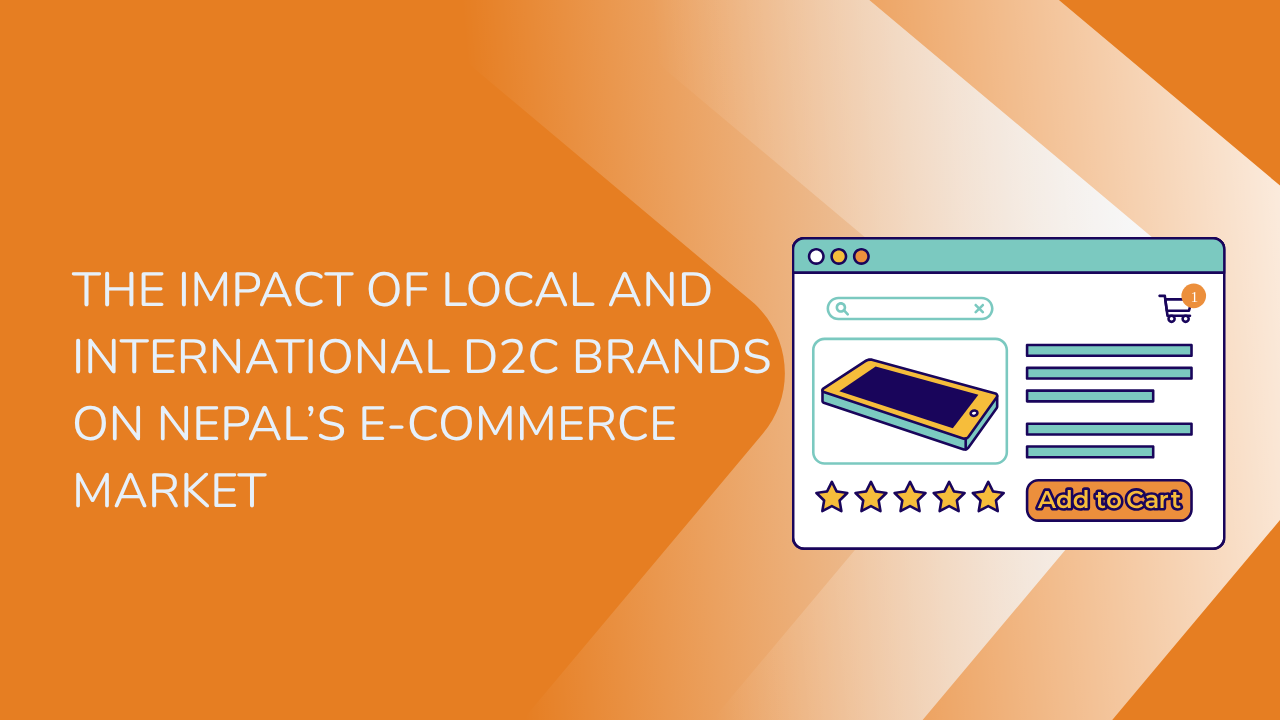Share this Article
In the ever-evolving world of global commerce, the Direct-to-Consumer (D2C) business model is gaining traction, disrupting traditional retail channels, and enabling brands to develop closer connections with their customers. As consumer behavior continues to shift toward online shopping and more businesses embrace digital-first strategies, the D2C model is transforming how brands operate worldwide. Nepal, with its vibrant young population, increasing internet connectivity, and evolving retail landscape, is quickly becoming a hub for D2C growth. This blog explores the rise of D2C brands in Nepal, the key factors driving their success, the challenges they face, and what the future holds for this emerging e-commerce model in the Himalayan nation.
Defining D2C and Its Relevance to Nepal
The Direct-to-Consumer (D2C) model refers to a business strategy where companies bypass traditional middlemen like wholesalers, retailers, and distributors to sell their products or services directly to end consumers. This model allows businesses to have greater control over their product offerings, pricing, customer experience, and overall brand image. D2C companies typically use their own e-commerce websites or third-party online platforms to reach customers, often leveraging digital marketing and social media to build brand awareness and foster customer loyalty.
In Nepal, this model is still in its early stages but is rapidly gaining traction. Historically, Nepali businesses have relied on physical retail outlets or distributors to reach consumers, limiting their ability to directly interact with their target audience. However, as the digital ecosystem continues to grow and e-commerce infrastructure improves, more Nepali entrepreneurs are turning to the D2C model as a way to differentiate their businesses and engage with customers on a more personalized level.
Why D2C is Gaining Popularity in Nepal
Several key factors are driving the rise of D2C brands in Nepal. These include the country’s increasing digital penetration, evolving consumer expectations, cost advantages for businesses, and the growing demand for personalized experiences.
1. Digital Transformation and Connectivity
In recent years, Nepal has seen significant improvements in internet access and mobile phone usage. According to recent reports, internet penetration in Nepal has crossed the 70% mark, and the number of smartphone users is growing exponentially. With the majority of Nepali consumers now online, businesses are presented with an opportunity to reach a broader audience than ever before.
The rise of mobile-friendly e-commerce platforms and the proliferation of digital wallets like eSewa, Khalti, and IME Pay have made online shopping more accessible. These advancements have been particularly accelerated by the COVID-19 pandemic, which forced many consumers to adopt digital solutions for shopping, banking, and other services.
For D2C brands, this shift toward digital shopping provides a fertile ground for growth. They can now tap into a growing base of tech-savvy consumers who are comfortable making online purchases, especially in urban areas like Kathmandu, Pokhara, and Lalitpur. As a result, more Nepali entrepreneurs are embracing the D2C model, offering a wide range of products—from clothing and cosmetics to groceries and electronics—directly to consumers via online channels.
2. Young, Tech-Savvy Population
Nepal boasts one of the youngest populations in South Asia, with nearly 40% of the population under the age of 25. This youthful demographic is not only highly engaged with social media platforms but is also becoming more financially independent and willing to spend on lifestyle products. Young consumers are more inclined to adopt new technology, seek out innovative products, and experiment with new shopping experiences, which makes them an ideal audience for D2C brands.
Millennials and Gen Z, in particular, are accustomed to the convenience of online shopping and are increasingly seeking brands that align with their values. They are more likely to trust companies that offer transparency, sustainability, and personalized experiences. D2C brands can engage with these consumers more directly through social media marketing, influencer partnerships, and interactive content, fostering long-term brand loyalty.
3. Cost Efficiency for Brands
One of the biggest advantages of the D2C model is the cost savings it offers businesses. Traditional retail requires multiple intermediaries, such as wholesalers, distributors, and retailers, each of whom adds a markup to the final price. By eliminating these middlemen, D2C brands can reduce their costs and offer products at more competitive prices.
For businesses in Nepal, this cost efficiency is especially important. With a relatively small domestic market, Nepali brands must compete with international players who often have economies of scale. By cutting out intermediaries, local D2C brands can offer unique products at prices that are attractive to consumers without sacrificing profit margins.
Additionally, D2C businesses retain more control over their pricing strategies, allowing them to adjust prices in real time based on demand, customer feedback, and market trends. This flexibility is a significant advantage in the highly competitive Nepali market, where consumers are becoming more price-sensitive due to economic challenges.
4. Personalization and Customer Experience
In the traditional retail model, brands often lose touch with their customers once the sale is made. In contrast, D2C brands are able to develop direct, ongoing relationships with their customers. Through digital platforms, they can gather valuable insights into customer preferences, behaviors, and feedback, which can be used to improve products and services.
This data-driven approach enables D2C brands to offer a more personalized experience, which is highly valued by Nepali consumers, especially younger generations. Whether it's customized product recommendations, tailored offers, or engaging customer service, D2C brands can create memorable experiences that build customer loyalty and lead to repeat business.
The Challenges Facing D2C Brands in Nepal
Despite the promising prospects of the D2C model in Nepal, there are several challenges that businesses must navigate to succeed. These challenges include logistical issues, payment barriers, consumer trust, and increasing competition.
1. Logistical Challenges
Nepal’s logistics infrastructure, while improving, remains a significant hurdle for e-commerce businesses. In urban areas like Kathmandu, Pokhara, and Biratnagar, logistics services are generally more reliable, but in rural and remote areas, access to timely and efficient delivery services can be inconsistent.
For D2C brands operating in Nepal, ensuring that products reach customers on time and in good condition is critical to building trust. Many areas still face challenges with road access, which can delay shipments. To overcome this, businesses need to partner with local couriers or invest in their own delivery systems to ensure a smooth and reliable logistics process.
2. Cash-Based Economy
Despite the rise of digital payment solutions in Nepal, the majority of transactions, especially in rural areas, are still conducted in cash. This can present challenges for D2C brands, especially those looking to scale quickly. While online payment systems such as eSewa, IME Pay, and Khalti are becoming increasingly popular, they are still not universally adopted across the country.
To successfully implement the D2C model, businesses must find ways to bridge the gap between digital payments and cash transactions. Offering cash-on-delivery (COD) options, for example, could help alleviate this issue while also catering to consumers who prefer paying in cash.
3. Building Consumer Trust
In Nepal, many consumers are still hesitant to purchase from unknown online stores due to concerns about product quality, payment security, and delivery reliability. Trust is a critical factor in the success of any e-commerce venture, and D2C brands must work hard to establish credibility in the minds of consumers.
To overcome this, D2C brands should prioritize transparency in their operations. Offering secure payment options, clear return and refund policies, and excellent customer support can help build consumer trust. Additionally, positive reviews, testimonials, and word-of-mouth recommendations can play a pivotal role in encouraging new customers to take the plunge and make a purchase.
4. Intensifying Competition
As the D2C model grows in Nepal, more businesses are likely to enter the market, leading to increased competition. This will make it more challenging for individual brands to stand out and capture the attention of consumers. To succeed in this competitive environment, D2C brands must focus on offering unique products, exceptional customer service, and innovative marketing strategies.
What the Future Holds for D2C Brands in Nepal
Despite the challenges, the future of D2C brands in Nepal looks bright, with several trends set to shape the e-commerce landscape in the coming years.
1. Growth of E-Commerce
As internet penetration continues to rise and more people become accustomed to online shopping, the overall e-commerce market in Nepal is expected to grow rapidly. This growth will create new opportunities for D2C brands to expand their reach and tap into an even larger customer base.
2. Social Media and Social Commerce
Social media is a powerful tool for D2C brands to engage with their target audience. In Nepal, platforms like Facebook, Instagram, and TikTok are increasingly being used for shopping and brand discovery. D2C brands that effectively leverage social media marketing will be able to engage consumers, promote their products, and drive sales.
Additionally, social commerce, or the ability to shop directly through social media platforms, is expected to grow in Nepal. By integrating e-commerce with social platforms, D2C brands can offer a seamless shopping experience that appeals to tech-savvy consumers.
3. Focus on Sustainability
Sustainability is a growing trend worldwide, and Nepali consumers are becoming more conscious of the environmental impact of their purchases. D2C brands that prioritize eco-friendly packaging, sustainable sourcing, and ethical production practices will likely see increased demand from environmentally conscious shoppers.
4. Improved Logistics and Delivery Solutions
As Nepal’s logistics infrastructure continues to improve, D2C brands will be able to offer faster, more reliable delivery services to customers, both in urban and rural areas. The rise of local courier services, as well as partnerships with established delivery companies, will streamline the logistics process and help D2C brands scale their operations more efficiently.
Conclusion
The rise of D2C brands in Nepal represents a major shift in the country's retail landscape. As more Nepali entrepreneurs embrace this model, the e-commerce market is poised for significant growth. While challenges such as logistical hurdles, payment barriers, and competition remain, the opportunities for innovation, customer engagement, and personalization are immense.
For businesses in Nepal, adopting the D2C model offers a unique opportunity to connect with consumers, deliver exceptional experiences, and build long-lasting relationships. As digital infrastructure improves and consumer behavior continues to evolve, D2C brands will play an increasingly important role in shaping the future of e-commerce in Nepal.
The key to success in the D2C space lies in delivering unique value, fostering trust, and embracing the digital transformation that is sweeping across the country. With the right strategies, the future of D2C brands in Nepal is bright, and entrepreneurs have a tremendous opportunity to make their mark in the evolving e-commerce landscape.
Categories:
Beginner’s Guides
Tags:
E-commerce







